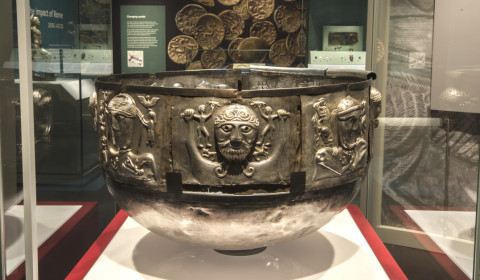
The Celts occupy a somewhat romantic and wild position in the British imagination. This new exhibition in conjunction with the British Museum has helped to spark new interest in these enigmatic peoples. I’ll be honest, I always had a mental image of primal tribes led by thunderous figures and advised by mysterious groups of druids. It was only when the BBC screened a three-part series on the Celts that I realised how wrong I was! The Celts exhibition originally ran at the British Museum. It opened at the National Museum of Scotland on 10 March.
What does the exhibition include?

The exhibition covers a range of time periods relating to the Celts. It begins with their mysterious origins some 2500 years ago. At this point, they’re at their most impenetrable. The statues and carvings pulse with a sense of the infinite. The maps dotted throughout the rooms help to demonstrate just how far-reaching the tribes labelled as ‘Celt’ were.
I hadn’t fully appreciated that the Celts and the people of the Iron Age weren’t mutually exclusive groups. The earliest Iron Age objects feature lots of intricate patterns. Animal motifs are everywhere! It’s a very distinctive style that’s instantly recognisable. It’s also common across a wider geographic area than I’d previously thought. The aesthetics at this point are perhaps at their most ‘pure’, and the style begins to evolve following contact with the Romans, Christianity, and the Vikings.

Each epoch is given its own room, and various examples of jewellery, art and weaponry are displayed. They all demonstrate the different forms that so-called ‘Celtic’ art took. A lot of the jewellery takes the form of torcs and all I can say is “Wow”! I’d pretty much wear any of them now! The level of craftsmanship displayed by people usually dismissed as “barbaric” is astonishing. Their techniques yield impressive results, despite their more rudimentary technology.
What happened to the Celts?
The Celtic style fell apart in the medieval era, particularly in the United Kingdom. The new British kingdoms of Scotland, England, Ireland and Wales each strove to forge their own regional identities. Their Celtic heritage became secondary to their sense of nationality. Similar ideas were resurrected most recently during the Scottish referendum. References to the Celts were rediscovered in the 15th century, and ideas around them were disseminated using the newly-invented printing press. Sadly disparate cultures and time periods were crammed together under the Celtic umbrella, regardless of how much they actually had to do with the style. In a way, this affects a lot of how popular culture perceives the Celts today.
Are the Celts really relevant now?

Definitely. The Celtic Revival really came into its own in the 19th Century, particularly as part of Ireland’s fight for Home Rule. This politicisation of the style foreshadows the use of Celtic mythology and imagery in more recent times. That said, it’s hardly a new concept. During the Roman occupation of Great Britain, indigenous Britons used Celtic jewellery and iconography to express their non-Roman identity and culture in the face of the invading style. History constantly circles back on itself. This exhibition proves that this circle might be two or more millennia in circumference, but it is there nonetheless. It’s important to study these ancient cultures in order to understand the way that societies relate to one another now.
Is the exhibition worth a visit?

Absolutely! There are over 300 objects on display, including the famous Gundestrup cauldron. They’re beautiful works of art in their own right, and should be appreciated for their aesthetic value as well as their historical importance. That said, they’re also fascinating from a social and a cultural point of view. The exhibition is on until 25 September 2016, and you can get more information here.






Have your say!